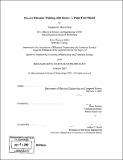Passive dynamic walking with knees : a point foot model
Author(s)
Hsu Chen, Vanessa F. (Vanessa Fang)
DownloadFull printable version (6.177Mb)
Other Contributors
Massachusetts Institute of Technology. Dept. of Electrical Engineering and Computer Science.
Advisor
Russ Tedrake.
Terms of use
Metadata
Show full item recordAbstract
In this thesis, a hybrid model for a passive 2D walker with knees and point feet is presented. The step cycle of the model has two phases of continuous dynamics: one with an unlocked knee configuration and a second one with a locked knee configuration. These stages are modeled as three-link and two-link pendulums correspondingly. The model switches between the two stages at knee-strike and heel-strike, which are both discrete events modeled as instantaneous inelastic collisions. The dynamics of this model were fully derived analytically. Furthermore, a stable gait was found given a set of physical parameters and initial conditions. A basic stability analysis of this stable limit cycle was performed around the fixed point of the Poincar6 return map examined right after heel-strike. This thesis also presents the design and construction of a planar robot based on this kneed walker model, as well as a careful examination of its correspondence to the motion predicted by the model simulation. The goal is to be able to study the nonlinear dynamics of simplified dynamic models which are also physically realizable, in order to build robots based on them in a more rigorous and reproducible manner. The work presented here aims to bridge the gap between existing theoretical models and successful experiments in passive dynamic walking.
Description
Thesis (M. Eng.)--Massachusetts Institute of Technology, Dept. of Electrical Engineering and Computer Science, 2007. Includes bibliographical references (p. 57-59).
Date issued
2007Department
Massachusetts Institute of Technology. Department of Electrical Engineering and Computer SciencePublisher
Massachusetts Institute of Technology
Keywords
Electrical Engineering and Computer Science.